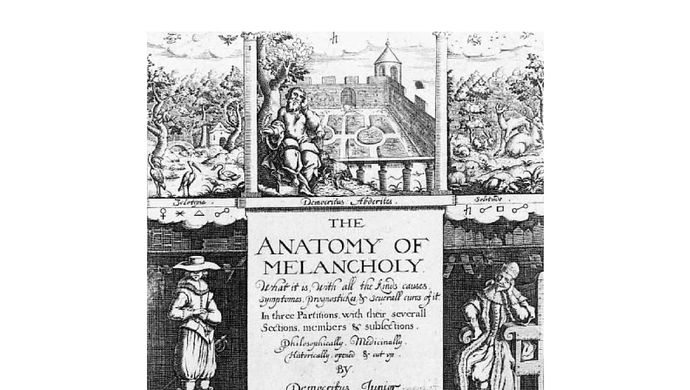Melancholy as a status symbol
Has any composer better given voice to melancholia than John Dowland? His was an age (the turn of the Seventeenth Century, straddling the reigns of Elizabeth I and James I) when public displays of private sorrow were in fashion, facilitated by wealthy patrons bringing musicians and poets into their homes–fitting venues for intimate, introspective art. Melancholia, in this sense, was more than simply misery and depression, but something approaching a status symbol. The lute song was the perfect, and uniquely English, medium for artistic expression of this kind, the lute having found its way from Moorish Spain to England in the 16th Century, and having trickled down the English classes (played by Henry VIII, Elizabeth I, and their courtiers alike). John Dowland was the master of the form; his First Book of Ayres, published in 1597, marked the beginning of a brief but extraordinarily fruitful Golden Age of the lute song–its popularity aided in no small part by an increasingly busy printing press.
It would be facile to attempt to link Dowland’s predilection for sadness in his music with a perceived unhappy personal life. For a start, we don’t know enough about his life to make this assertion. Though he failed to gain a post as court lutenist to Elizabeth I in 1594 (likely because he had converted to Catholicism), he found renown abroad as lutenist to Christian IV in Denmark, and was eventually appointed one of James I’s ‘Musicians for the Lutes’ in his own country. Thomas Fuller, in his ‘History of Worthies of England’ (1662) describes him as ‘a cheerful person, passing his days in lawful merriment’. And though Dowland himself in his note to the reader of his ‘Pilgrimes Solace’ (1612) rails against ‘young-men, professers of the Lute, who vaunt themselves, to the disparagement of such as have been before’, and of others who ‘give their verdicte of me behinde my backe’, betraying a touch of professional insecurity, he ends the same note by assuring the reader that the book was ‘pleasing to me in the composition’. Tempting though it might be to cast him as the tortured artist nonpareil, the preponderance of melancholia in his music can be more satisfactorily explained by the fashions of the time.
Like many of the songs (or ‘ayres’) in Dowland’s First Book, Can She Excuse my Wrongs was originally printed as a four-part madrigal, to be performed informally in the homes of the middle classes. But the advent of the lute and its tablature enabled polyphonic music of this sort to be written out for one instrument, with the voice singing the melody: the main requirement being digital dexterity on the part of the lutenist. The song takes the form of a Galliard, a sprightly dance popular with Queen Elizabeth I, with lyrics believed to have been written by Robert, Earl of Essex, sometime love interest of the Queen. That the lyrics were later bolted on to the tune, with unusual word stresses often resulting, seems likely.
Dowland’s genius is equally apparent in his instrumental work as in his vocal compositions; indeed the pieces are often one and the same. Mignarda and Captain Digorie Piper, His Galliard are both melancholy galliards, lyricised as Shall I strive with words to move and If my complaints could passions move respectively. Both are shining examples of the bittersweet quality Dowland achieves by combining the jumping rhythms of the dance with his distinct dolefulness. The typical form in Renaissance lute music was to repeat each section ornamented in such a way as to fill in the gaps – known as divisions. This can be heard in these pieces and also to great effect in John Danyel’s Pavan.
It has been suggested that I saw my Lady weep and Flow my Tears, which sit side by side in Dowland’s Second Book (1600), were composed as a pair, with the latter intended to complete the former. Musically, the theory is an attractive one, as the first of the songs ends on the fifth, with the vocal line ending on the leading-tone; Flow my Tears then begins on the tonic, providing resolution. Both songs are sophisticated in their use of syncopation and chromaticism, while Flow my Tears opens with a ‘falling tear motif’, a four-note descending scale likely borrowed from madrigal.
While Dowland’s development of his style would take him away from dances towards songs like the deeply through-composed, free-flowing and abruptly-ending In Darkness let me Dwell (A Musicall Banquet, 1610), his close contemporary Thomas Campion favoured, and indeed argued frequently for, a more succinct style of composition. He was a polymath in the Renaissance sense, as adept a poet (in both English and Latin) as he was a composer, which would explain his natural facility for word-setting. No bolted-on lyrics here, rather words perfectly suited to each note. His foreword to the reader of Rosseter’s Book of Ayres (1601) provides fascinating insight into his compositional method: he compares ‘Ayres in musicke' to ‘Epigrams in Poetrie…in their chief perfection when they are short and well seasoned’. He opposes those who ‘to appeare the more deepe, and singular in their judgement, will admit no Musicke but that which is long, intricate, bated with fuge, chaind with sincopation…’, and states he finds that ‘rests have no use’. A style, then, quite different from Dowland: when you listen to each of The Cypress Curtain of the Night, I Care not for these Ladies, and Never Weather-Beaten Sail, you may notice that there is no point at which the lute plays without the voice.
Campion makes no secret of his mixing the divine with the profane: he writes “Holy hymns with lovers’ cares are knit both in one quire here” (Second Book of Ayres, 1613). The two songs by Thomas Ford on this recording fall firmly into the latter category. Both come from his ‘Musicke of Sundrie Kindes’ (1607). The one, Fair, Sweet, Cruel, is a simple tale of unrequited courtship, told lightly, concluding with the resigned refrain “Hey ho, chill (“I’ll”) love no more”. The other, What then is Love, goes slightly deeper, comparing Corydon’s love of ‘coy Phillida’ to a ‘scantie dearth in fullest store’, and a ‘morning rose…that which then flourisht quickly dies’, in its perennial futility. The characters of Corydon and Phyllida appear in Nicholas Breton’s poem of 1591, in which romance is compared to the fertility (or otherwise) of the earth. Both names would have instantly conjured up pastoral images in the mind of the Elizabethan reader or listener–the former appears in the pastoral poetry of Virgil and Theocritus as a stock name for a shepherd. Indeed, Classical allusions in Renaissance England could accord great cachet to the lute song, the lute being the natural English heir to the ancient Greek Cithara.
If there was a composer to rival Dowland’s facility with counterpoint and range of melancholic expression, it was John Danyel. Both held Bachelor’s Degrees in Music from Oxford University, but Danyel seems to have been held in greater favour than Dowland at Court: he was ‘Master of the Revels to the Queen’, and one of her royal lutenists. Only one collection of his songs, published in 1606, survives. Dedicated to a Mrs Anne Greene (first ‘privately compos’d’, now ‘publikely disclos’d), it contains a remarkable song-triptych, written for a widow (‘Mrs M.E.’) on the death of her husband, whose lyrics meditate on the inadequacy of tears and sighs for mourning, and whose music, full of chromaticism and lute-voice counterpoint, matches anything written by Dowland, even if Campion may not have approved.
Dowland was often called the English Orpheus. Decades after he and his contemporaries had died, and the flowering of the English Lute song had passed, a new Golden Age of English music emerged, led by Henry Purcell, ‘Orpheus Britannicus’. This programme ends with two of his songs on a ground bass, played on the theorbo, a cousin of the lute.
Alexander Chance & Toby Carr








